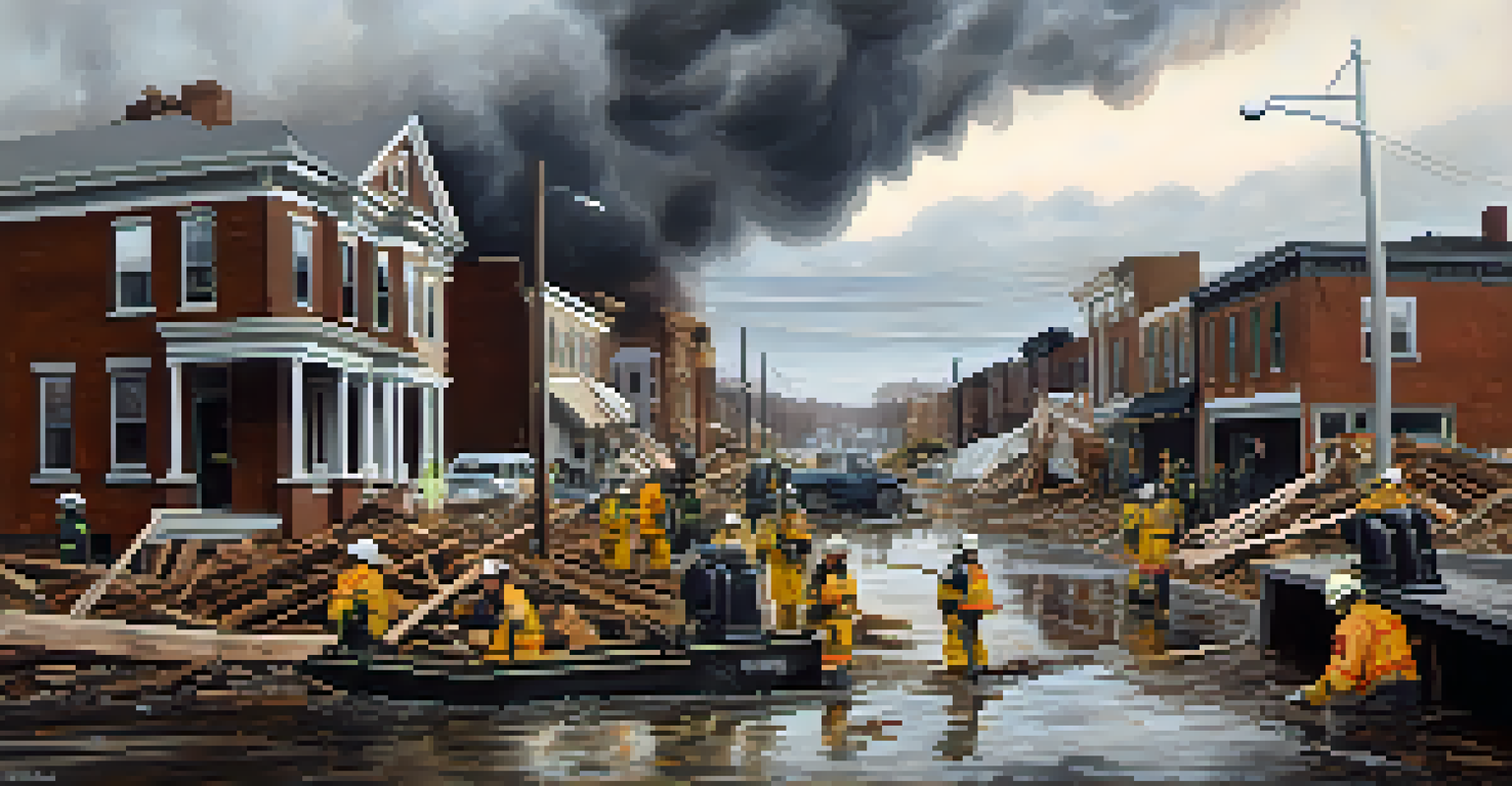The Great Molasses Flood: Boston's Sticky Disaster of 1919

The Background of the Great Molasses Flood
In the early 1900s, molasses was a significant commodity in the United States, used in everything from food to industrial products. Boston, with its bustling ports and thriving economy, became a hub for molasses storage. The Purity Distilling Company built a massive tank in 1915 to store molasses for rum production, an ambitious project that would soon lead to disaster. Little did they know that this seemingly innocent tank would become the epicenter of one of the most bizarre tragedies in American history.
Safety isn't just a slogan, it's a way of life.
At the time, the tank stood 50 feet tall and could hold over 2.3 million gallons of molasses, a sight that drew both curiosity and concern from locals. Many residents reported hearing strange noises and feeling vibrations from the tank, but nothing was done to address their worries. The combination of poor construction and inadequate safety measures set the stage for an event that would leave the city reeling. It’s a classic example of how ignoring the signs can lead to catastrophic outcomes.
The molasses tank was filled to the brim, and with the hot summer approaching, the pressure inside was building. The situation was precarious, and it was only a matter of time before something gave way. As residents went about their daily lives, they had no idea that a sticky disaster was just around the corner, waiting to unfold in a matter of seconds.
The Day of the Flood: January 15, 1919
On January 15, 1919, at approximately 12:30 PM, the unthinkable happened. The massive molasses tank ruptured with a thunderous roar, unleashing a wave of thick, brown syrup that surged through the streets of Boston's North End. This wave reached speeds of up to 35 miles per hour, sweeping away everything in its path, including buildings, vehicles, and even unsuspecting pedestrians. It was as if a giant tidal wave of molasses had descended on the city, transforming a bustling neighborhood into a sticky nightmare.

Witnesses described the scene as surreal; the molasses flowed with a heavy, viscous consistency, making escape nearly impossible for those caught in its path. The flood caused significant destruction, demolishing homes and businesses, and it quickly became clear that this disaster was not just a quirky accident but a serious catastrophe. First responders were faced with a daunting task, as they struggled to rescue victims trapped in the gooey mess. In a matter of minutes, lives were lost, and the community was forever changed.
The Catastrophic Molasses Flood
On January 15, 1919, a ruptured molasses tank unleashed a devastating wave through Boston, resulting in significant destruction and loss of life.
In the aftermath of the flood, 21 people lost their lives, and many others were injured. The once-bustling streets of the North End were transformed into a sticky wasteland, leaving residents to grapple with the emotional and physical toll of the disaster. As cleanup efforts began, the gravity of the situation became clear—this was not just an unfortunate event; it was a tragedy that would haunt the city for years to come.
The Impact on the Local Community
The Great Molasses Flood had a profound impact on the local community, both immediately and in the long term. In the days following the disaster, residents came together to support one another, as many lost their homes and livelihoods. Local businesses were devastated, and the recovery process was slow and arduous. The community faced the challenge of rebuilding while also dealing with the emotional scars left by the tragedy.
An ounce of prevention is worth a pound of cure.
In addition to the physical damage, the flood also sparked a sense of distrust towards large companies and their safety practices. Many residents began to question how such a catastrophe could happen in their own backyard. This incident served as a wake-up call, leading to increased scrutiny of industrial safety regulations. The molasses flood became a cautionary tale about the importance of proper infrastructure and corporate responsibility.
As the community rebuilt, they found strength in unity. Local organizations and citizens banded together to support those in need, fostering a sense of resilience. This spirit of cooperation would become a defining characteristic of Boston, helping the city heal from the sticky disaster that had once threatened to tear it apart.
Legal Ramifications and Accountability
In the wake of the flood, questions arose about accountability and responsibility for the disaster. Many residents filed lawsuits against the Purity Distilling Company, seeking justice for the losses they had suffered. The legal proceedings highlighted the negligence of the company in maintaining the integrity of the tank, as well as the lack of adequate safety measures. This became a significant case in the realm of corporate liability and public safety.
The courts eventually ruled in favor of the victims, emphasizing that the company had failed to uphold its duty to ensure the safety of its operations. The judgment not only provided financial compensation to those affected but also served as a precedent for future industrial safety cases. It underscored the critical need for regulations that protect communities from corporate negligence, a lesson that resonates even today.
Community Resilience Shines
In the aftermath of the disaster, Boston's community came together to support one another, fostering a spirit of unity and resilience.
The legal aftermath of the Great Molasses Flood marked a turning point in how industrial disasters were addressed in the United States. The case prompted lawmakers to reconsider safety standards and regulations, ultimately leading to stricter guidelines for the construction and maintenance of large storage facilities. While the flood had devastating consequences, it also acted as a catalyst for change, shaping the future of industrial safety.
Remembering the Great Molasses Flood
Decades later, the Great Molasses Flood is still remembered as one of Boston's most unusual disasters. It serves as a poignant reminder of the fragility of life and the importance of safety measures in industrial practices. Each year, locals and historians gather to commemorate the lives lost and the resilience of the community that emerged from the tragedy. This event has become a part of Boston's rich history, woven into the fabric of the city's identity.
The flood has also inspired various cultural references, from books and documentaries to local lore. It highlights how a seemingly mundane substance like molasses could lead to such chaos, captivating the imaginations of future generations. The story serves as a reminder that sometimes, the most unexpected events can leave a lasting impact on a community.
In recent years, the story of the Great Molasses Flood has found its place in educational settings, where it is used to teach important lessons about safety, responsibility, and community resilience. By sharing this unique chapter of history, we ensure that the lessons learned from this sticky disaster are not forgotten and continue to resonate with future generations.
The Legacy of the Great Molasses Flood
The legacy of the Great Molasses Flood extends far beyond its immediate aftermath. It serves as a historical lesson about the need for stringent safety regulations in industrial practices. The disaster prompted changes in laws and regulations that aimed to protect communities from similar catastrophes. As a result, the flood played a crucial role in shaping modern industrial safety standards, ensuring a more secure environment for future generations.
Furthermore, the flood has become a symbol of resilience and community strength. The way the people of Boston came together to support one another during the recovery period is a testament to their unwavering spirit. This aspect of the disaster has been celebrated in various forms, from public memorials to community events that honor the victims and their families.
Regulatory Changes Follow Disaster
The Great Molasses Flood prompted significant legal and regulatory changes aimed at improving industrial safety standards and accountability.
Today, the Great Molasses Flood is a part of Boston's collective memory, reminding us that even in the face of tragedy, communities can unite and emerge stronger. It underscores the importance of vigilance and preparedness in preventing future disasters, making it a relevant topic in discussions about industrial safety and community resilience.
Lessons Learned from the Great Molasses Flood
The Great Molasses Flood teaches us valuable lessons about preparedness and the importance of safety protocols. One of the most significant takeaways is the need for regular inspections and maintenance of industrial structures. Companies must prioritize the safety of their operations, not only for their benefit but also for the communities in which they operate. This disaster serves as a powerful reminder that neglect can lead to devastating consequences.
Another lesson revolves around the importance of community vigilance. Residents should feel empowered to voice their concerns about local industrial practices and infrastructure. The warning signs observed by the North End community before the flood highlight the necessity of listening to local voices. When people are actively engaged in their communities, they can help prevent future tragedies.

Finally, the flood illustrates the need for effective communication between corporations, regulators, and the public. Transparency in safety practices and disaster preparedness can foster trust and collaboration. By learning from the mistakes of the past, we can create a safer environment for everyone and ensure that the Great Molasses Flood remains a cautionary tale rather than a repeated tragedy.